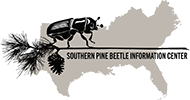Abstract
The research field of animal and plant symbioses is advancing from studying interactions between two species to whole communities of associates. High-throughput sequencing of microbial communities supports multiplexed sampling for statistically robust tests of hypotheses about symbiotic associations. We focus on ambrosia beetles, the increasingly damaging insects primarily associated with fungal symbionts, which have also been reported to support bacteria. To analyze the diversity, composition, and specificity of the beetles’ prokaryotic associates, we combine global sampling, insect anatomy, 454 sequencing of bacterial rDNA, and multivariate statistics to analyze prokaryotic communities in ambrosia beetle mycangia, organs mostly known for transporting symbiotic fungi. We analyze six beetle species that represent three types of mycangia and include several globally distributed species, some with major economic importance (Dendroctonus frontalis, Xyleborus affinis, Xyleborus bispinatus–ferrugineus, Xyleborus glabratus, Xylosandrus crassiusculus, and Xylosandrus germanus). Ninety-six beetle mycangia yielded 1,546 bacterial phylotypes. Several phylotypes appear to form the core microbiome of the mycangium. Three Mycoplasma (originally thought restricted to vertebrates), two Burkholderiales, and two Pseudomonadales are repeatedly present worldwide in multiple beetle species. However, no bacterial phylotypes were universally present, suggesting that ambrosia beetles are not obligately dependent on bacterial symbionts. The composition of bacterial communities is structured by the host beetle species more than by the locality of origin, which suggests that more bacteria are vertically transmitted than acquired from the environment. The invasive X. glabratus and the globally distributed X. crassiusculus have unique sets of bacteria, different from species native to North America. We conclude that the mycangium hosts in multiple vertically transmitted bacteria such as Mycoplasma, most of which are likely facultative commensals or parasites.
To read the full article please visit the link below:
Hulcr, J., N. R. Rountree, S. E. Diamond, L. L. Stelinski, N. Fierer, and R. R. Dunn. 2012. “Mycangia of Ambrosia Beetles Host Communities of Bacteria.” Microbial Ecology 64 (3): 784–93. https://doi.org/10.1007/s00248-012-0055-5.
